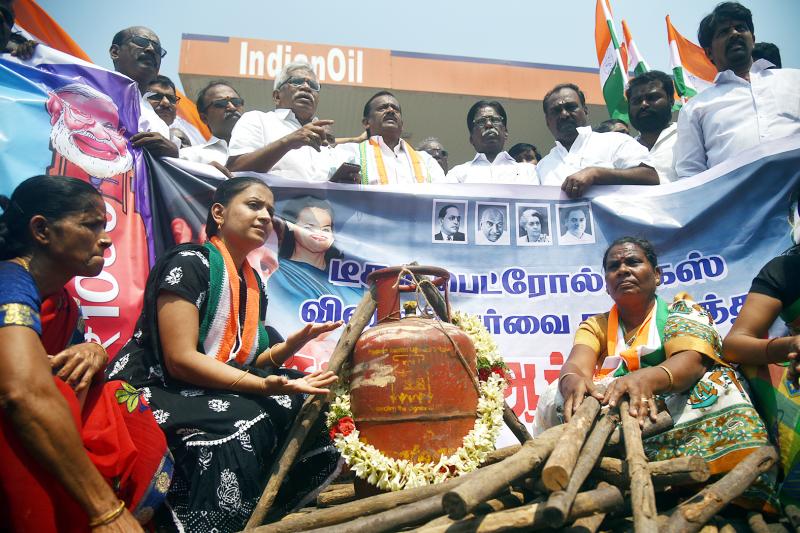Russia is offering India steep discounts on the direct sale of oil, as mounting international pressure lowers the appetite for its barrels elsewhere following the invasion of Ukraine, people with knowledge of the matter said.
The sanctions-hit nation is offering its flagship Urals grade to India at discounts of as much as US$35 a barrel on prices before the war to lure India to increase its shipments, the people said, asking not to be identified discussing confidential deliberations.
Headline Brent prices have risen about US$10 since then, implying an even larger reduction from current prices.

Photo: EPA-EFE
Russia wants India to take 15 million barrels contracted for this year just to begin with, they said, adding that the talks are taking place at government level.
Asia’s No. 2 oil importer is among a handful of nations that have been doubling down on Russian crude, defying international pressure and sanctions.
Russian barrels have been flowing to Asia in greater volumes, as buyers across Europe and the US shun the supply following the invasion of Ukraine. India and China have been the key buyers.
Russia has also offered rupee-ruble-denominated payments using Russia’s messaging system SPFS, which could make trading more attractive for India, they said.
No final decision has been taken and the matter will probably be discussed after Russian Minister of Foreign Affairs Sergey Lavrov’s arrival in India yesterday for a two-day visit.
The direct purchase is expected to involve Russia’s Rosneft PJSC and the Asian nation’s biggest processor Indian Oil Corp, which have an optional term contract — which is rarely used — for close to 15 million barrels a year. It is not clear what the upper end of the buying might be, but India is thought to have limited appetite for the grades being offered.
That contract has a built-in clause that Indian Oil would buy only when it is economical, the people said, adding that a discount offered by Russia could make the oil trade viable even at a higher freight.
“India’s intake of Russian oil has been very small for many, many years,” said Vandana Hari, founder of oil market analysis provider Vanda Insights in Singapore. “So the refineries are not configured to buy a lot of Russian oil.”
Representatives for Indian Oil did not immediately reply to calls seeking comment and the Indian Ministry of Petroleum and Natural Gas declined to comment.
The two sides are exploring routing the oil through Russia’s Vladivostok Port in the far east to avoid shipping hurdles from the Baltic Sea in the west of the country. From there, oil shipments could reach India’s east coast refineries in fewer than 20 days, they said.
India is also seeking to push for greater exports of medicines, engineering goods and chemicals to Russia to narrow its trade gap created by oil and arms purchases.
Urals crude has been trading at discounts since the war began. Litasco, the trading arm of Russia Lukoil PJSC, offered a cargo of Urals at a discount of US$31.35 to the Dated Brent benchmark in a pricing window organized by S&P Global Platts last week.
There were no bids, and it was a deeper discount than a record-low offer by Glencore PLC a little more than a week before. China buys a different grade of oil from Russia.

Intel Corp chief executive officer Lip-Bu Tan (陳立武) is expected to meet with Taiwanese suppliers next month in conjunction with the opening of the Computex Taipei trade show, supply chain sources said on Monday. The visit, the first for Tan to Taiwan since assuming his new post last month, would be aimed at enhancing Intel’s ties with suppliers in Taiwan as he attempts to help turn around the struggling US chipmaker, the sources said. Tan is to hold a banquet to celebrate Intel’s 40-year presence in Taiwan before Computex opens on May 20 and invite dozens of Taiwanese suppliers to exchange views

Application-specific integrated circuit designer Faraday Technology Corp (智原) yesterday said that although revenue this quarter would decline 30 percent from last quarter, it retained its full-year forecast of revenue growth of 100 percent. The company attributed the quarterly drop to a slowdown in customers’ production of chips using Faraday’s advanced packaging technology. The company is still confident about its revenue growth this year, given its strong “design-win” — or the projects it won to help customers design their chips, Faraday president Steve Wang (王國雍) told an online earnings conference. “The design-win this year is better than we expected. We believe we will win

Chizuko Kimura has become the first female sushi chef in the world to win a Michelin star, fulfilling a promise she made to her dying husband to continue his legacy. The 54-year-old Japanese chef regained the Michelin star her late husband, Shunei Kimura, won three years ago for their Sushi Shunei restaurant in Paris. For Shunei Kimura, the star was a dream come true. However, the joy was short-lived. He died from cancer just three months later in June 2022. He was 65. The following year, the restaurant in the heart of Montmartre lost its star rating. Chizuko Kimura insisted that the new star is still down

While China’s leaders use their economic and political might to fight US President Donald Trump’s trade war “to the end,” its army of social media soldiers are embarking on a more humorous campaign online. Trump’s tariff blitz has seen Washington and Beijing impose eye-watering duties on imports from the other, fanning a standoff between the economic superpowers that has sparked global recession fears and sent markets into a tailspin. Trump says his policy is a response to years of being “ripped off” by other countries and aims to bring manufacturing to the US, forcing companies to employ US workers. However, China’s online warriors